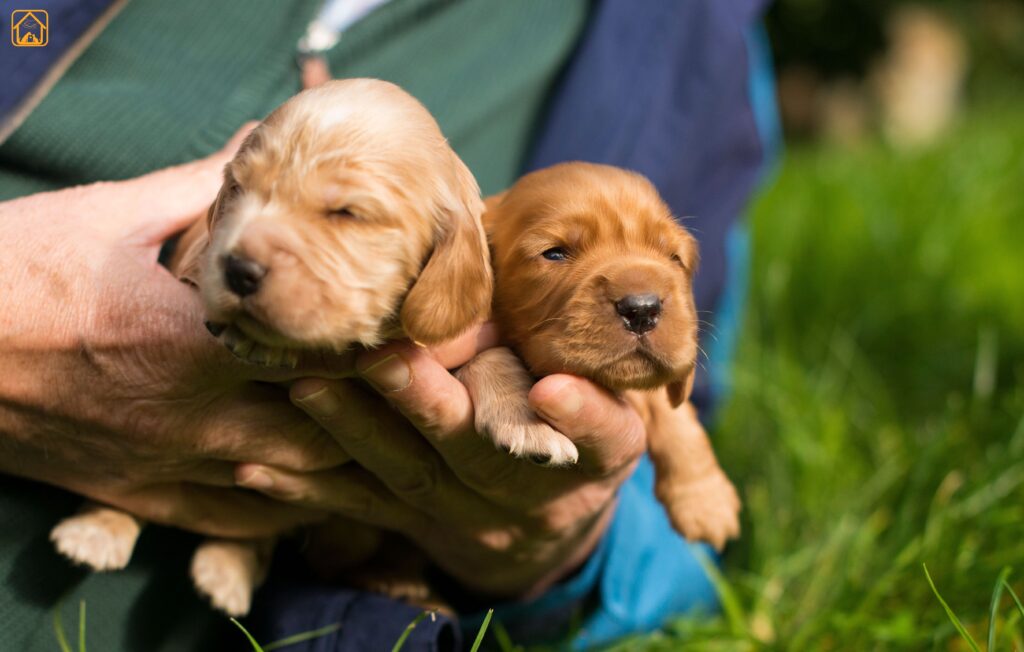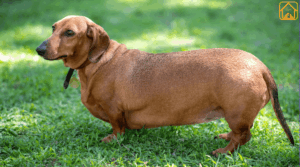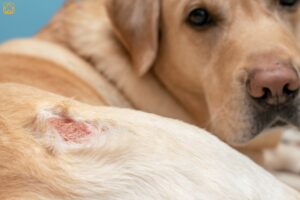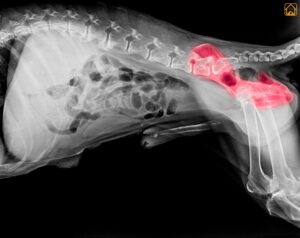Labrador Pregnancy Symptoms and Early Signs
Recognizing the first signs of labrador pregnancy helps you provide timely care and reassurance. While some symptoms are subtle, knowing what to look for will help you spot changes early.
I remember my own yellow Lab, Bunny, suddenly becoming extra cuddly and sleeping more. At first, I thought she was just having an off day but it turns out her way of adjusting to pregnancy.
Here are some common Labrador pregnancy symptoms to watch for:
- Appetite changes: Some Labradors might suddenly act picky with food, while others seem like they’re always hungry. It’s common for them to eat less in the early weeks, then get a bigger appetite later in pregnancy.
- Energy shifts: If your Lab is sleeping more than usual, it’s likely just part of early pregnancy. She might spend hours lounging in her favorite cozy spot and taking it easy.
- Behavioral changes: Pregnant Labs can act more clingy following you everywhere or the opposite, wanting more alone time. Either way, it’s normal and part of how she’s adjusting.
- Physical changes: By week three or four, her nipples may look larger and pinker than usual. She might gain a little weight at first, but it’s not always obvious. After a few weeks, you may notice her belly starting to look rounder. Though it can be tricky to notice under all that thick fur.
- Increase in urination: As the puppies grow, they press against her bladder, making her need more bathroom breaks just like in human pregnancy.
- Nesting behaviors: Closer to the due date, she may start scratching at her bedding, circling, or hiding out in quiet spots. This nesting behavior means she’s getting ready for the pups.
Here’s a quick symptom timeline for reference:
| Pregnancy Stage | Common Symptoms |
| Weeks 1-2 | Subtle or no symptoms; watch for mild appetite or mood changes |
| Weeks 3-4 | Appetite loss, lethargy, nipple changes, possible nausea |
| Weeks 5-6 | Weight gain, increased appetite, firmer abdomen |
| Weeks 7-9 | Nesting, visible belly, lactation, restlessness |
If you notice these signs, especially after a recent dog heat cycle, reach out to your vet for a proper confirmation. They may recommend an ultrasound around week 3 or 4.
Gestation Period for Labradors: How Long Are They Pregnant?
The gestation period for labrador retrievers is usually 63 days, or about nine weeks, from conception to delivery. Sometimes, the pregnancy of a labrador dog can range from 58 to 68 days, depending on individual factors. Most Labs will show clearer pregnancy signs during the third or fourth week, but the full labrador pregnancy period follows this general timeline:
- Week 1-2: Fertilization and embryo travel
- Week 3-4: Implantation and early development; first vet confirmation possible
- Week 5-7: Major growth and visible belly changes
- Week 8-9: Final puppy development and birth preparation
To visualize where you are in the labrador pregnancy cycle, here’s a quick reference table:
| Week | Physical Changes | Behavioral Changes |
| 1 | Fertilization; no visible changes | May seem normal; slight fatigue |
| 2 | Embryo migration; minimal changes | Possibly mild appetite loss |
| 3 | Implantation in uterus; subtle nipple changes | Gentle mood shifts, extra affection |
| 4 | Nipples pinken, slight abdominal swelling | Might rest more, less energetic |
| 5 | Fetal growth accelerates; abdomen enlarges | Increased appetite, calm demeanor |
| 6 | Weight gain, mammary glands develop | Nesting behaviors may begin |
| 7 | Puppies grow hair, more obvious swelling | Restlessness, seeking quiet |
| 8 | Puppies mature; milk may appear | Nesting increases, may be anxious |
| 9 | Final prep for birth; vulva softens | Reduced appetite, pacing, reclusive |
Why is knowing the gestation period important? Because timing helps you prepare, from vet visits to setting up a cozy whelping area. It also means you’ll catch any problems early.
By the way, the gestation period for Labradors is nearly identical to other breeds, but Labs often have slightly larger litters (the average is 6-8 puppies!).
Remember, every Lab is unique. If you’re unsure about dates or symptoms, your vet can help with checkups and guidance at every stage of your Labrador retriever’s pregnancy.
Exercise, Activity, and Environmental Needs During Labrador Pregnancy

Labrador’s health during pregnancy goes beyond nutrition it’s about finding the right balance of gentle exercise, mental stimulation, and a comfortable environment. The right routine helps minimize stress, keeps your dog in good shape for labor, and supports healthy puppy development throughout the labrador pregnancy period.
How Much Exercise Does a Pregnant Labrador Need?
- Weeks 1–4: Continue daily walks and light play. Avoid vigorous runs or rough play, which could risk embryo implantation.
- Weeks 5–7: Shift to shorter, more frequent walks. Let her set the pace, she may tire more quickly as her abdomen grows.
- Weeks 8–9: Limit activity to very gentle walks for bathroom breaks. Most Labs prefer to rest and nest as labor approaches.
Listen to your dog if she seems tired or disinterested, never force activity. Gentle movement supports circulation and helps prevent excessive weight gain, but rest is equally important.
Environmental Comforts for Pregnant Labradors
As your Labrador’s pregnancy progresses, she’ll appreciate a calm, quiet space to relax. Set up a soft bed in a quiet corner and stick to her usual routine. Keep the home peaceful by avoiding loud noises or big changes. A warm, cozy spot free of drafts is especially helpful.
Mental Stimulation and Socialization
Pregnancy doesn’t mean your Lab should be bored. Give her gentle puzzle toys, short training sessions, and calm affection to keep her happy. Avoid anything too exciting or tiring. Skip rough play or jumping just let her enjoy slow walks and simple activities that keep her mentally and emotionally comfortable.
Prenatal Care: Nutrition and Vet Visits
Good nutrition is one of the most important parts of caring for your pregnant Labrador. During this time, she needs a balanced diet that supports both her and her growing puppies. Choose a high-quality dog food labeled for “all life stages” or one approved by your vet for pregnancy.
These formulas offer the right mix of protein, fat, and nutrients. Avoid giving extra vitamins or calcium unless your vet specifically recommends it, too much can actually cause problems. Always keep fresh water available, and as her appetite grows, consider feeding smaller meals more often to keep her comfortable.
Regular vet checkups are a must during your Labrador’s pregnancy. Your vet can confirm the pregnancy, check your dog’s health, and give advice on what to expect at each stage. They’ll help you track weight gain, monitor the puppies’ development, and spot any signs of trouble early.
Around day 45, an ultrasound or X-ray may be done to count the puppies. Don’t skip appointments, your vet’s guidance makes sure both mom and her litter stay healthy. If anything seems off, like unusual behavior or appetite loss, it’s always best to check in with your vet right away.
The Whelping Process: Stages of Labor and What to Expect
This is where things get real. The whelping process is nature’s miracle, and yes, it’s a little messy, sometimes a bit nerve-wracking, but also deeply moving. Understanding the stages of labor helps you support your Labrador retriever confidently and calmly.
Stage One: Early Labor (6–18 hours)
- Your Lab may seem restless, pace, pant, shiver, or dig at blankets. Some lose their appetite, vomit, or whine.
- She’s likely building a nest, classic nesting behavior.
- Her temperature may drop about 12–24 hours before the first puppy arrives (from around 101°F to 98–99°F).
- This stage is about contractions and dilation. You probably won’t see visible contractions yet, just discomfort and fussiness.
What you do: Keep the whelping area calm and quiet. Offer water, but don’t force food. Give her space, but stay close. Jot down the time when you notice early labor signs.
Stage Two: Active Labor & Delivery (3–12 hours, longer for big litters)
- Stronger contractions begin, and soon you’ll see the first puppy appear, often still in its fluid-filled sac.
- Puppies are usually born every 30–60 minutes. Sometimes mom takes a longer break, up to 4 hours, between pups, especially with big litters.
- After each puppy, a placenta follows. It’s normal for the mother to eat some or all placentas, it provides nutrients and hormones.
- Mom will lick each puppy to clean it, bite the umbilical cord, and stimulate breathing. If she doesn’t, you’ll need to gently tear the sac, clear the puppy’s mouth and nose, and rub it briskly with a towel.
What you do: Stay calm, keep towels handy, and quietly encourage her. If a puppy seems stuck for more than 20–30 minutes or mom is straining hard with no progress, call your vet right away. Don’t hesitate, sometimes quick action saves lives.
Stage Three: Afterbirth & Recovery
- After the last puppy, mom delivers any remaining placentas and fluids.
- Mild panting, shaking, or resting is normal. She’ll usually settle in to nurse her pups within an hour.
What you do: Offer fresh water, change soiled bedding if mom allows, and let her bond with her babies. Count placentas, there should be one per puppy. If any are missing, let your vet know, as retained placentas can cause infection.
Labrador Litter Size and What Affects It
The average labrador litter size is around 6 to 8 puppies, but anywhere from 1 to 13 is possible. Things like mom’s age, health, genetics, and nutrition can all play a role. First-time moms often have smaller litters. By week 8, your vet can often estimate the final count with an x-ray.
Postpartum Care for Mother and Puppies

The hard part’s over, but your job as a pet parent is just getting started. The days and weeks after whelping are crucial for your Lab and her puppies. Here’s how to help everyone thrive:
- Keep the whelping area clean: Change bedding daily (or more if needed). Puppies and mom need a dry, warm spot.
- Monitor mom’s health: She might be tired, but should eat, drink, and nurse her puppies. Watch for fever, foul-smelling discharge, or loss of appetite, these can signal infection or complications.
- Nutrition boost: Nursing Labs need two to three times their usual calories. Feed your Labrador a high-quality puppy food or a vet-recommended formula. Our Labrador Feeding Guide can help you get started on the right paw. And don’t forget: fresh water is always a must.
- Check puppies often: Healthy pups are warm, quiet, and nurse frequently. Weigh them daily, they should gain weight steadily. If any seem weak, cold, or not feeding, call your vet.
- Umbilical cords and care: Usually, the mother handles this, but keep an eye out for any bleeding or swelling at the cord site. Gently clean if needed with warm water.
- Limit visitors: Give mom and pups time to bond and rest. Too much excitement can stress her out.
- Watch for postpartum issues: Heavy bleeding, tremors, high fever, or not caring for puppies are red flags. Don’t wait, contact your vet if anything feels off.
Oh, and get ready for some serious cuteness overload. Puppy squeaks, tiny noses, and mom’s pride, it’s a lot! Stay calm, keep your vet looped in, and trust your instincts.
Common Pregnancy Complications and Warning Signs
While most labrador pregnancies go smoothly, it’s good to know the warning signs. Watch for:
- Heavy or green discharge before labor begins
- Straining for over an hour with no puppy delivered
- More than four hours between puppies
- High fever, tremors, or sudden collapse in mom
- Puppies that aren’t breathing, nursing, or moving
Note: False pregnancy with the signs like nesting or milk production with no puppies, can also happen.
Additionally, explore our full guide on Labrador health issues to stay informed and proactive.
FAQs About Labrador Pregnancy
1. How long is a Labrador’s pregnancy?
Labrador retrievers are usually pregnant for about 63 days (around 9 weeks), but the range can be 58 to 68 days. Start counting from the first day of mating.
2. What’s the ideal age for a Labrador to have puppies?
A Labrador should be at least 2 years old before her first pregnancy. Breeding after age 6 isn’t recommended due to health risks.
3. How can I tell if my Labrador is pregnant?
Look for signs like appetite changes, tiredness, mild weight gain, and nipple enlargement. A vet can confirm pregnancy by ultrasound or blood test from week 3 or 4.
4. How do I calculate my Labrador’s due date?
Use a Labrador pregnancy calculator by entering the mating date. If you’re unsure, your vet can estimate it using ultrasound or hormone testing.
5. How many puppies do Labradors usually have?
Most litters include 6–8 puppies, but anywhere from 1 to 13 is possible. Litter size depends on the mother’s age, health, and genetics.
6. Can my Labrador exercise while pregnant?
Yes! Gentle walks and calm play are great. Just avoid high-energy games, jumping, or anything strenuous—especially later in pregnancy. Always follow your vet’s advice.
7. What should I feed my pregnant Labrador?
Feed a vet-approved, high-quality food for pregnant or ‘all life stages’ dogs. Avoid supplements unless prescribed. In her final trimester, she’ll need extra nutrients and calories.
8. What are signs of labor in Labradors?
Signs include a drop in rectal temperature, nesting behavior, restlessness, panting, loss of appetite, and shivering. These usually begin a day or two before labor starts.
9. How should I prepare for my Labrador’s whelping?
Set up a quiet, warm whelping box with clean towels, a thermometer, gloves, and your vet’s number nearby. Introduce her to the space ahead of time.
10. What should I do if I suspect complications during labor?
Call your vet immediately if there’s heavy discharge, extreme straining without a puppy, long gaps between deliveries, or signs of distress like fever or lethargy.
For more expert advice, consult the AKC’s Dog Pregnancy Guide.
11. What is a phantom (false) pregnancy in Labradors?
It’s when your dog shows signs of pregnancy like nesting or producing milk but isn’t actually pregnant. It’s harmless but confusing. A vet can confirm.
12. Are there dog pregnancy tests?
There’s no home test for dogs. Only a vet can confirm pregnancy with an ultrasound (after day 21), blood tests, or physical exam.
13. Can Labradors have a week-by-week image guide?
Visible changes are minor until late in pregnancy, but you can find helpful week-by-week diagrams and updates on trusted veterinary websites or breeder resources.
14. How do I care for the puppies after birth?
Keep puppies warm, dry, and close to their mother. They should nurse every 2–3 hours and steadily gain weight. If a pup seems weak or cold, call your vet.
Conclusion
Remember every labrador pregnancy is unique. With attentive care, the right prep, and a loving approach, you’ll support your Lab through a safe and joyful journey to motherhood.



